Lợi ích từ việc giảng viên nhận xét tương tác vào bài viết tiếng Anh của sinh viên
Trong quá trình dạy và học viết tiếng Anh, giáo viên thường phản hồi trực tiếp vào bài viết của
sinh viên, làm cơ sở để người học chỉnh sửa trước khi hoàn thiện bài viết. Việc này được coi là
tốn thời gian, công sức của giáo viên, nhưng giới nghiên cứu vẫn đang tranh luận về hiệu quả của
nó đối với chất lượng bài viết. Trong nghiên cứu này, chúng tôi phân tích tác động của phản hồi
tương tác của giảng viên đối với chất lượng bài viết tiếng Anh của sinh viên Việt Nam học tiếng
Anh như một ngôn ngữ thứ 2. Chúng tôi thu thập trên 30 bài viết về 15 chủ đề của 03 sinh viên
đại học người Việt trong 24 tuần. Tác động của phản hồi tương tác được phân tích theo chuẩn
của Ferris, chất lượng bài viết được phân tích định tính theo chuẩn Viết Phân tích của Hoa Kỳ, so
sánh kết quả sử dụng phương pháp ANOVA (định lượng). Kết quả cho thấy, người học tiếp thu,
sử dụng gần 70% góp ý nhận xét của giảng viên, và có cơ sở thống kê để nhận định chất lượng
bài viết lần cuối cao hơn lần đầu, đặc biệt về nội dung, bố cục, văn phong (không cải thiện về sử
dụng từ và ngữ pháp). Kết quả nghiên cứu giúp cải thiện quy trình dạy và học viết tiếng Anh trình
độ đại học tại Việt Nam.
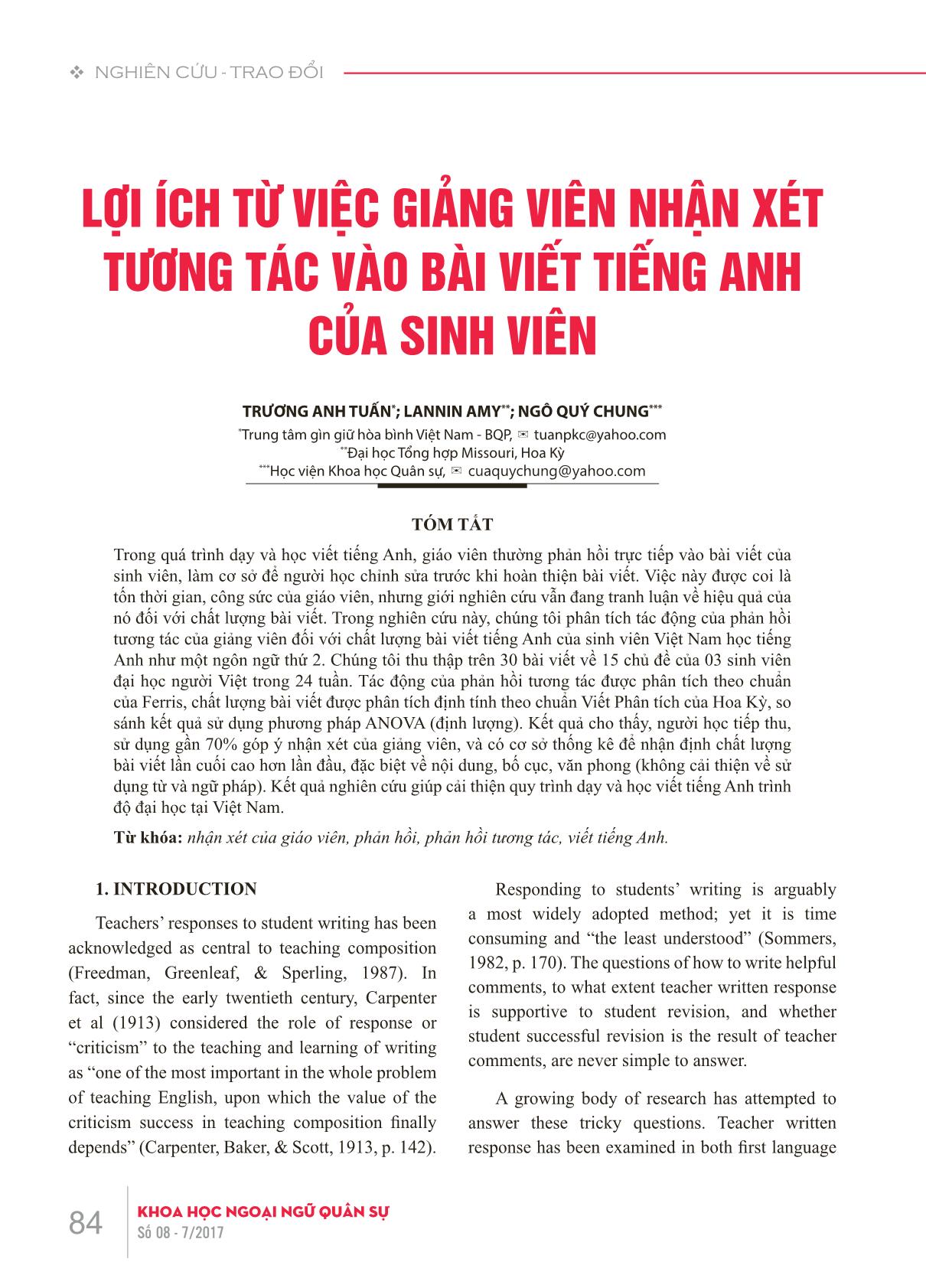
Trang 1
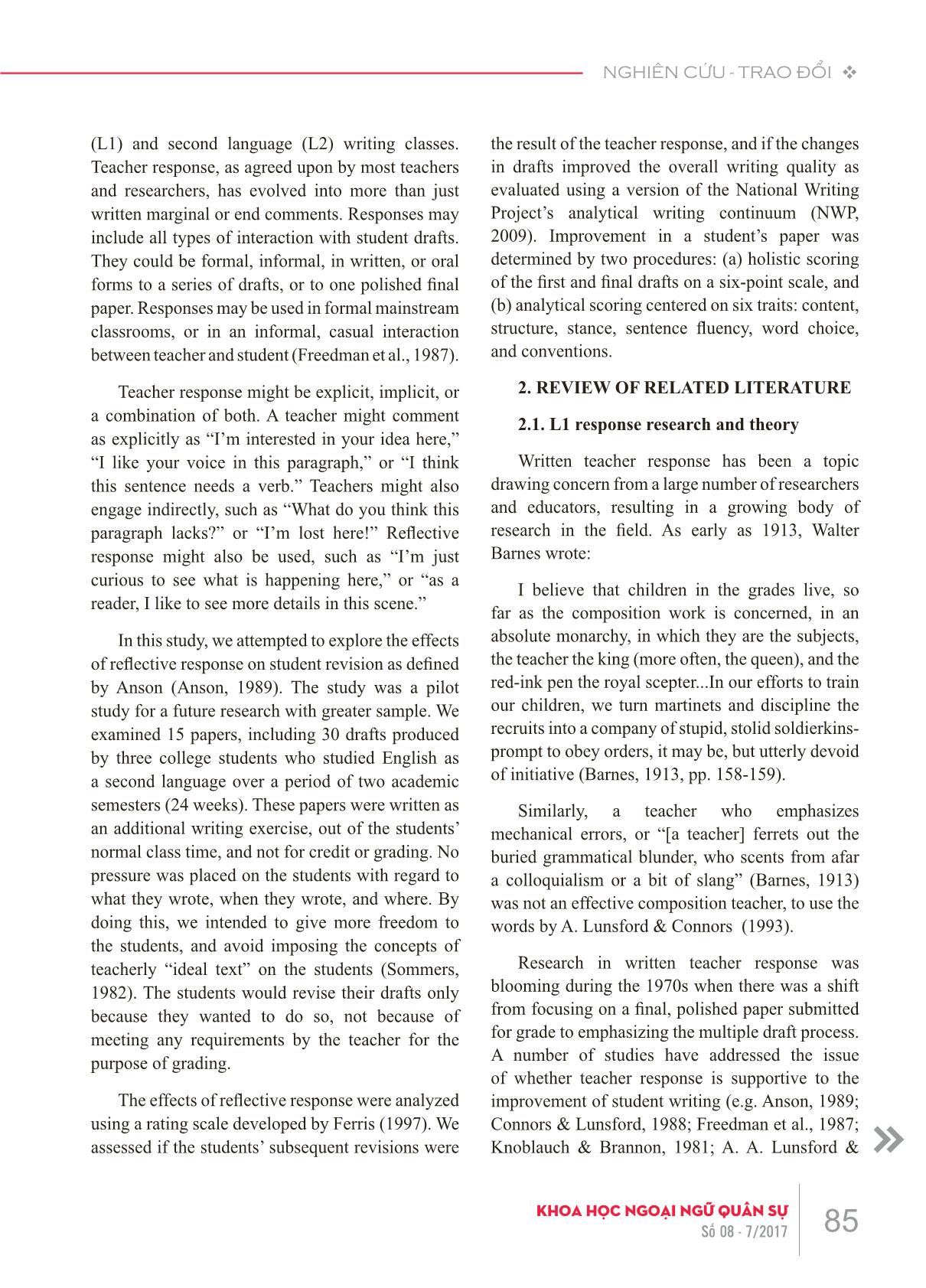
Trang 2
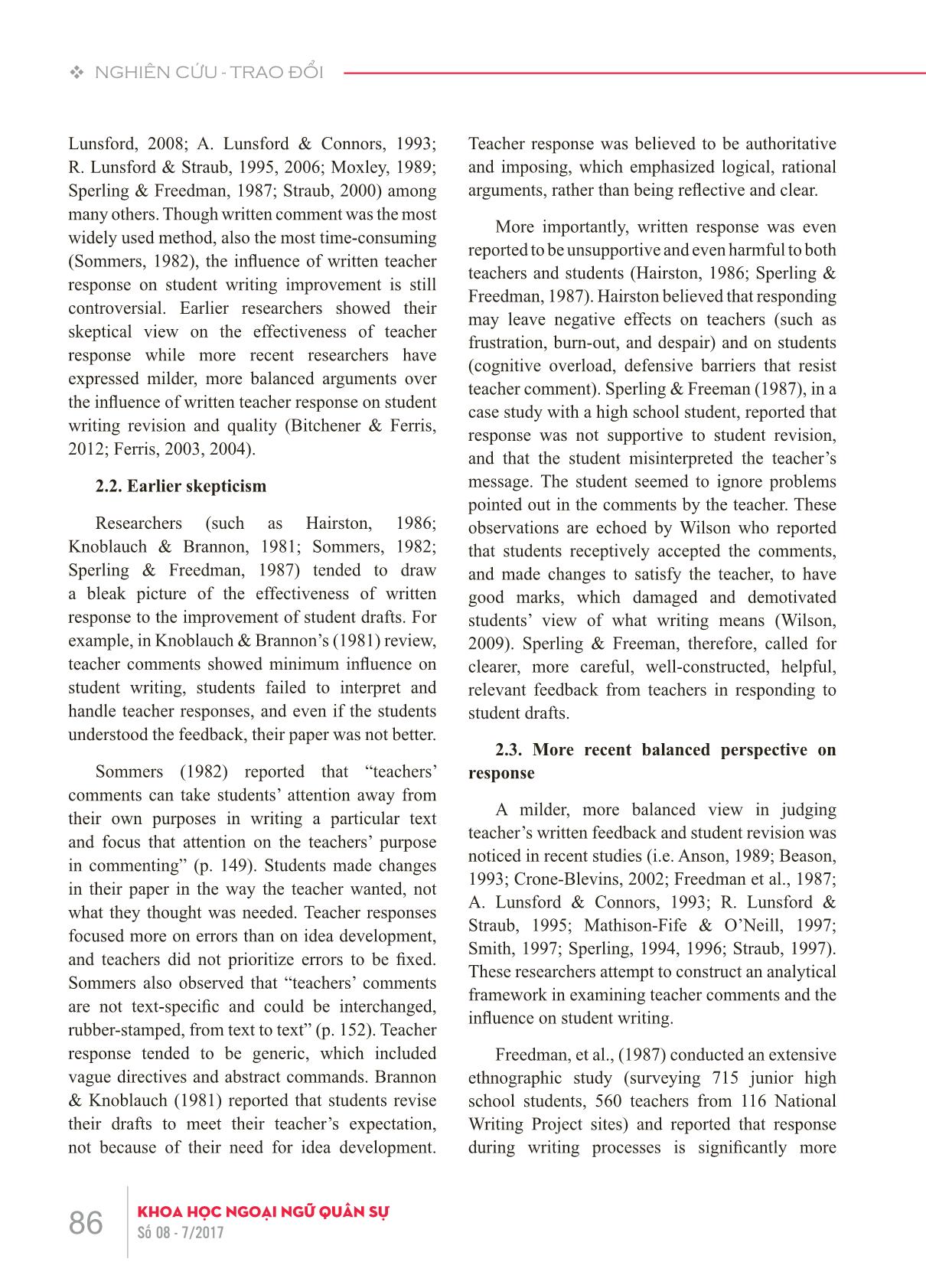
Trang 3
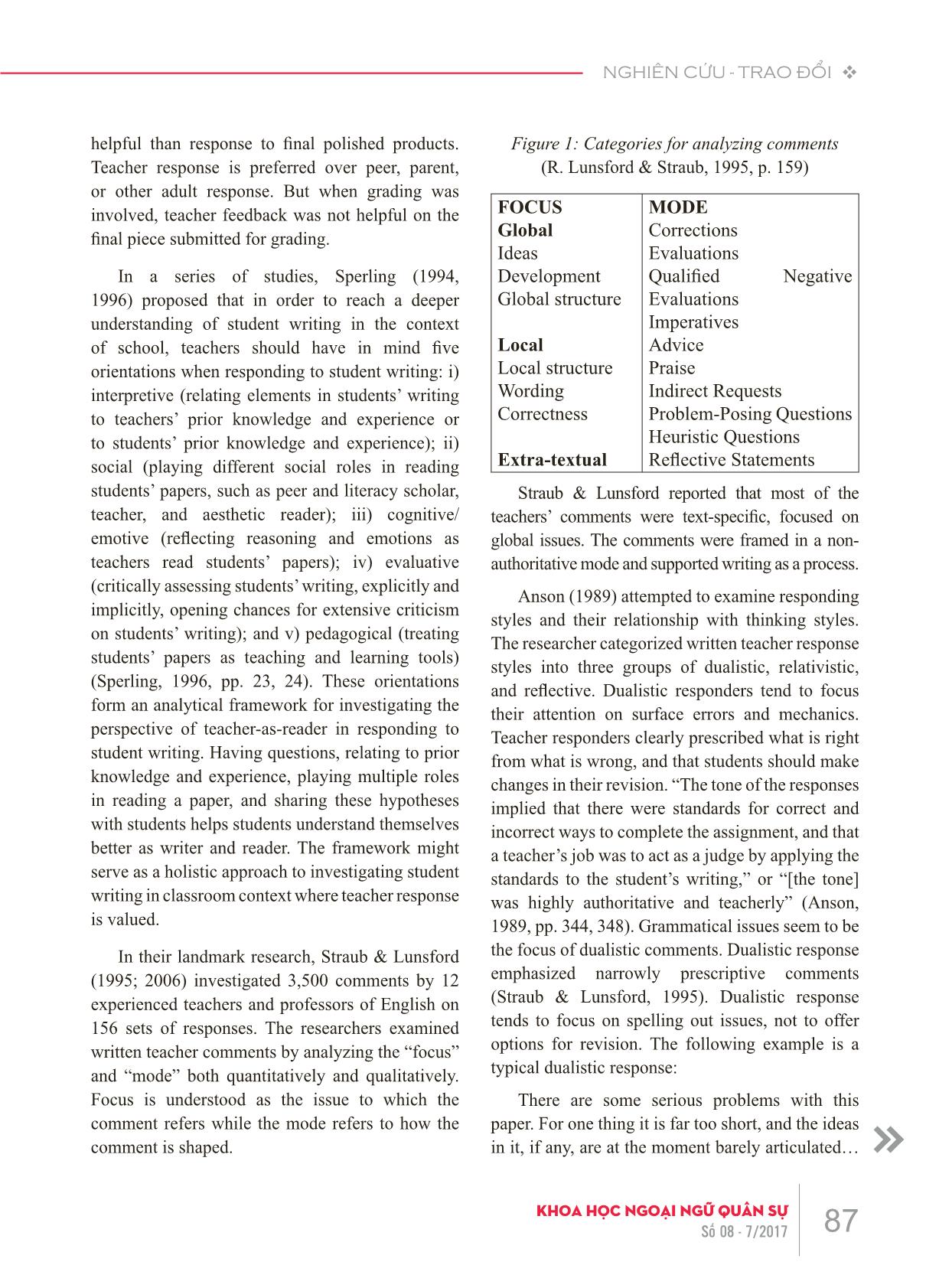
Trang 4
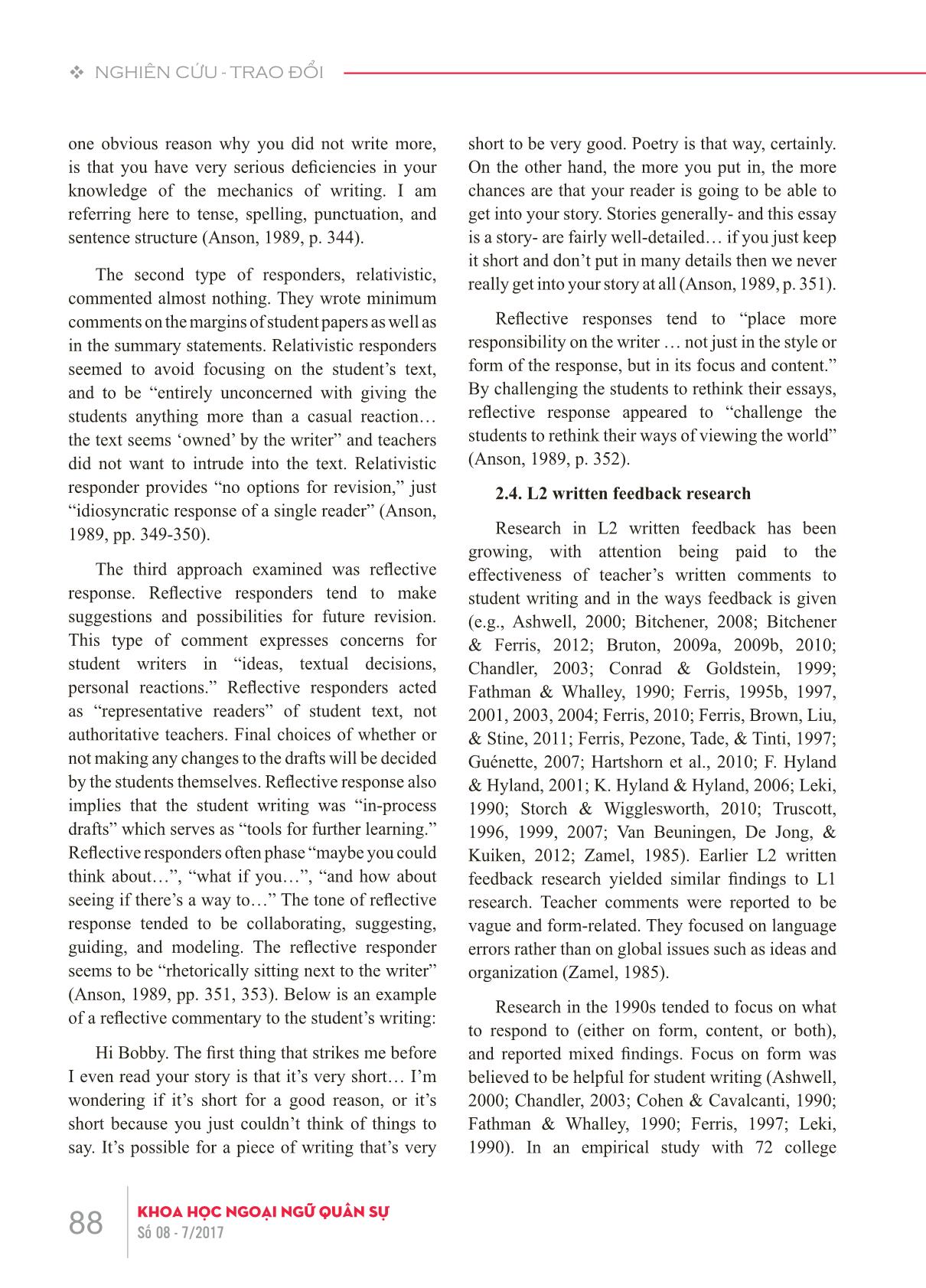
Trang 5
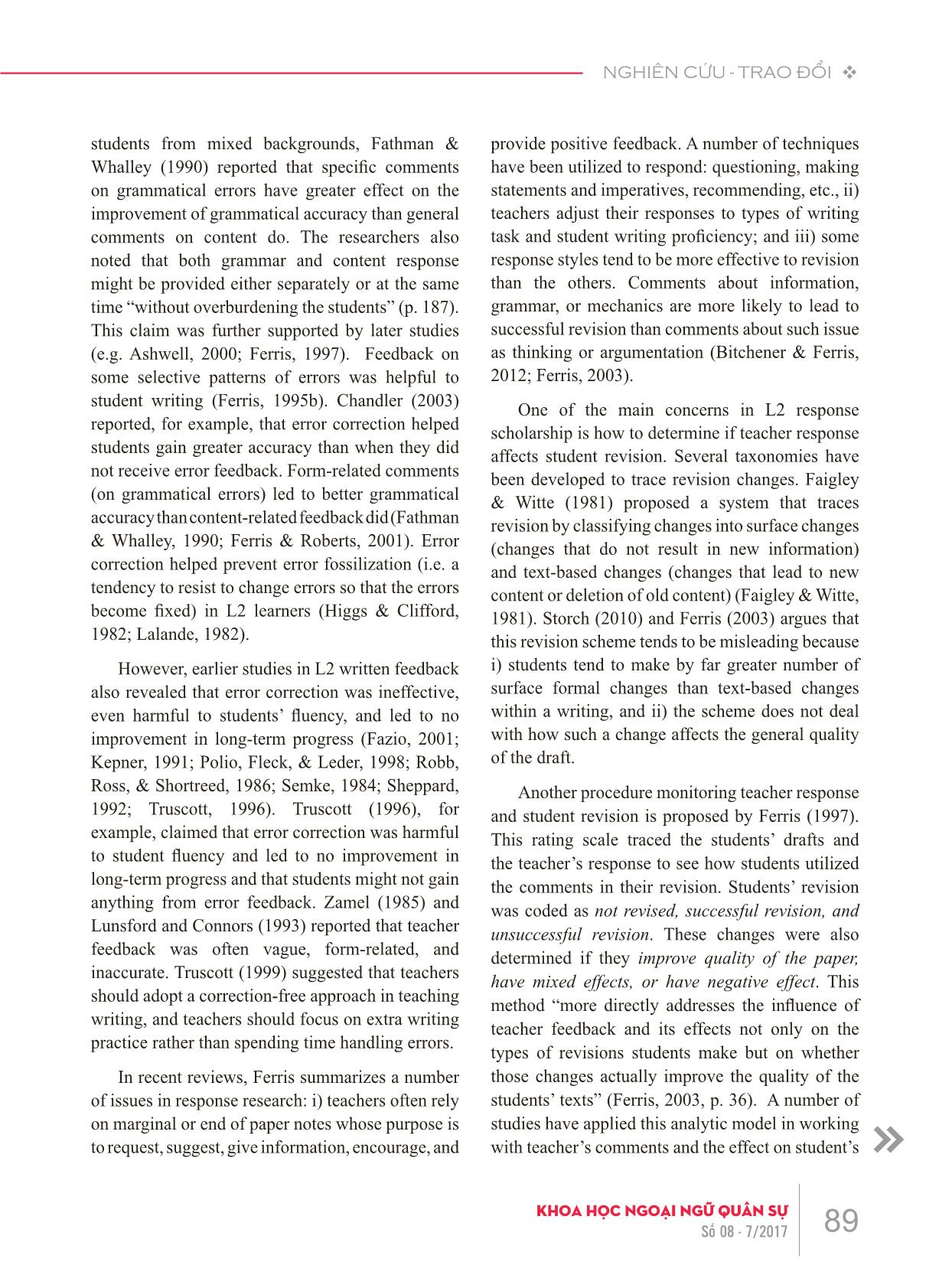
Trang 6
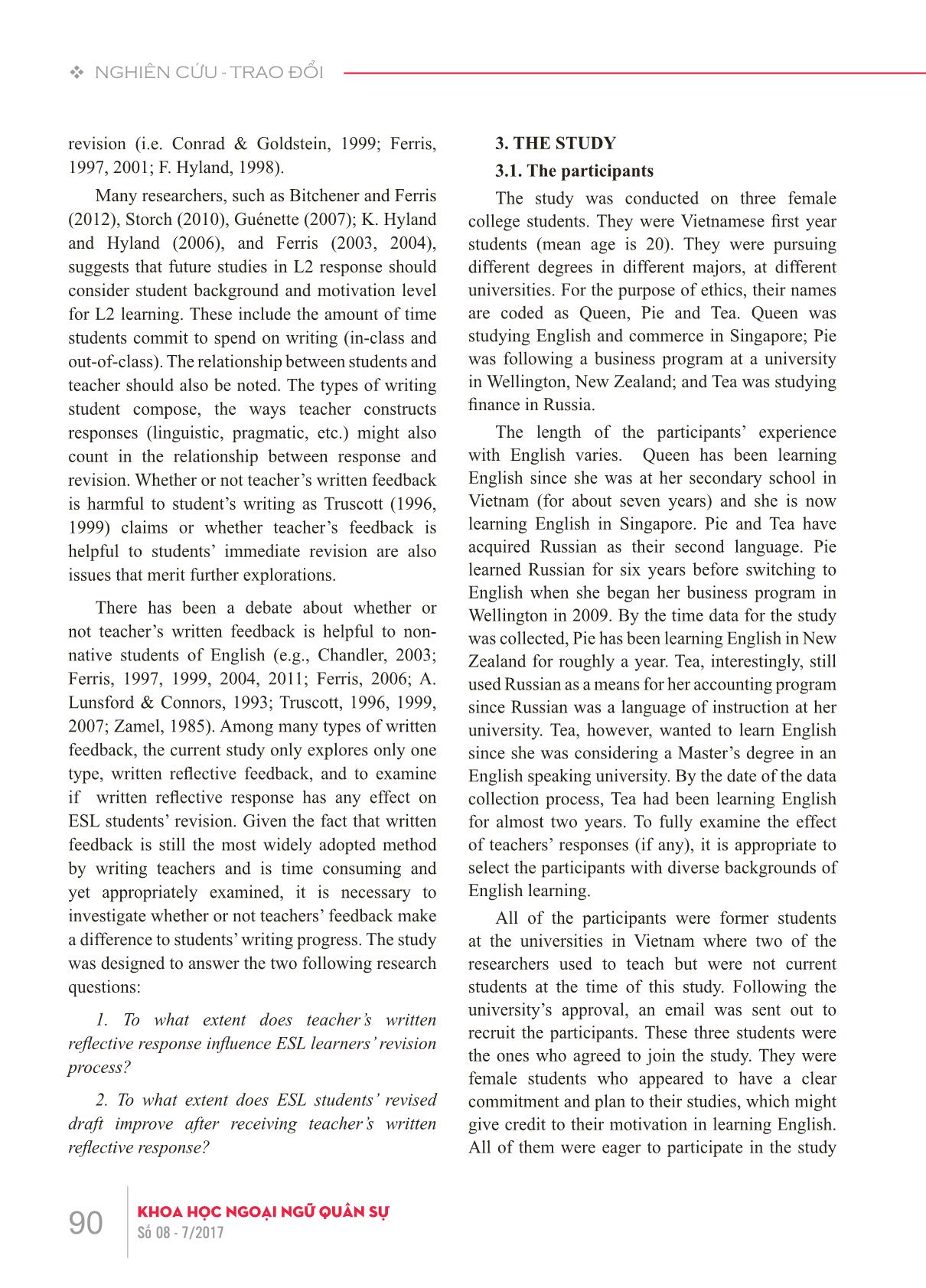
Trang 7
Tóm tắt nội dung tài liệu: Lợi ích từ việc giảng viên nhận xét tương tác vào bài viết tiếng Anh của sinh viên
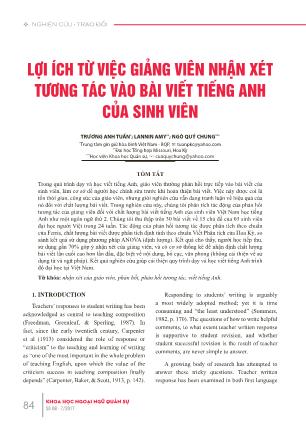
84 KHOA HỌC NGOẠI NGỮ QUÂN SỰSố 08 - 7/2017 v NGHIÊN CỨU - TRAO ĐỔI LỢI ÍCH TỪ VIỆC GIẢNG VIÊN NHẬN XÉT TƯƠNG TÁC VÀO BÀI VIẾT TIẾNG ANH CỦA SINH VIÊN 1. INTRODUCTION Teachers’ responses to student writing has been acknowledged as central to teaching composition (Freedman, Greenleaf, & Sperling, 1987). In fact, since the early twentieth century, Carpenter et al (1913) considered the role of response or “criticism” to the teaching and learning of writing as “one of the most important in the whole problem of teaching English, upon which the value of the criticism success in teaching composition finally depends” (Carpenter, Baker, & Scott, 1913, p. 142). Responding to students’ writing is arguably a most widely adopted method; yet it is time consuming and “the least understood” (Sommers, 1982, p. 170). The questions of how to write helpful comments, to what extent teacher written response is supportive to student revision, and whether student successful revision is the result of teacher comments, are never simple to answer. A growing body of research has attempted to answer these tricky questions. Teacher written response has been examined in both first language TÓM TẮT Trong quá trình dạy và học viết tiếng Anh, giáo viên thường phản hồi trực tiếp vào bài viết của sinh viên, làm cơ sở để người học chỉnh sửa trước khi hoàn thiện bài viết. Việc này được coi là tốn thời gian, công sức của giáo viên, nhưng giới nghiên cứu vẫn đang tranh luận về hiệu quả của nó đối với chất lượng bài viết. Trong nghiên cứu này, chúng tôi phân tích tác động của phản hồi tương tác của giảng viên đối với chất lượng bài viết tiếng Anh của sinh viên Việt Nam học tiếng Anh như một ngôn ngữ thứ 2. Chúng tôi thu thập trên 30 bài viết về 15 chủ đề của 03 sinh viên đại học người Việt trong 24 tuần. Tác động của phản hồi tương tác được phân tích theo chuẩn của Ferris, chất lượng bài viết được phân tích định tính theo chuẩn Viết Phân tích của Hoa Kỳ, so sánh kết quả sử dụng phương pháp ANOVA (định lượng). Kết quả cho thấy, người học tiếp thu, sử dụng gần 70% góp ý nhận xét của giảng viên, và có cơ sở thống kê để nhận định chất lượng bài viết lần cuối cao hơn lần đầu, đặc biệt về nội dung, bố cục, văn phong (không cải thiện về sử dụng từ và ngữ pháp). Kết quả nghiên cứu giúp cải thiện quy trình dạy và học viết tiếng Anh trình độ đại học tại Việt Nam. Từ khóa: nhận xét của giáo viên, phản hồi, phản hồi tương tác, viết tiếng Anh. TRƯƠNG ANH TUẤN*; LANNIN AMY**; NGÔ QUÝ CHUNG*** *Trung tâm gìn giữ hòa bình Việt Nam - BQP, ✉ tuanpkc@yahoo.com **Đại học Tổng hợp Missouri, Hoa Kỳ ***Học viện Khoa học Quân sự, ✉ cuaquychung@yahoo.com 85KHOA HỌC NGOẠI NGỮ QUÂN SỰSố 08 - 7/2017 NGHIÊN CỨU - TRAO ĐỔI v (L1) and second language (L2) writing classes. Teacher response, as agreed upon by most teachers and researchers, has evolved into more than just written marginal or end comments. Responses may include all types of interaction with student drafts. They could be formal, informal, in written, or oral forms to a series of drafts, or to one polished final paper. Responses may be used in formal mainstream classrooms, or in an informal, casual interaction between teacher and student (Freedman et al., 1987). Teacher response might be explicit, implicit, or a combination of both. A teacher might comment as explicitly as “I’m interested in your idea here,” “I like your voice in this paragraph,” or “I think this sentence needs a verb.” Teachers might also engage indirectly, such as “What do you think this paragraph lacks?” or “I’m lost here!” Reflective response might also be used, such as “I’m just curious to see what is happening here,” or “as a reader, I like to see more details in this scene.” In this study, we attempted to explore the effects of reflective response on student revision as defined by Anson (Anson, 1989). The study was a pilot study for a future research with greater sample. We examined 15 papers, including 30 drafts produced by three college students who studied English as a second language over a period of two academic semesters (24 weeks). These papers were written as an additional writing exercise, out of the students’ normal class time, and not for credit or grading. No pressure was placed on the students with regard to what they wrote, when they wrote, and where. By doing this, we intended to give more freedom to the students, and avoid imposing the concepts of teacherly “ideal text” on the students (Sommers, 1982). The students would revise their drafts only because they wanted to do so, not because of meeting any requirements by the teacher for the purpose of grading. The effects of reflective response were analyzed using a rating scale developed by Ferris (1997). We assessed if the students’ subsequent revisions were the result of the teacher response, and if the changes in drafts improved the overall writing quality as evaluated using a version of the National Writing Project’s analytical writing continuum (NWP, 2009). Improvement in a student’s paper was determined by two procedures: (a) holistic scoring of the first and final drafts on a six-point scale, and (b) analytical scoring centered on six traits: content, structure, stance, sentence fluency, word choice, and conventions. 2. REVIEW OF RELATED LITERATURE 2.1. L1 response research and theory Written teacher response has been a topic drawing concern from a large number of researchers and educators, resulting in a growing body of research in the field. As early as 1913, Walter Barnes wrote: I believe that children in the grades live, so far as the composition work is concerned, in an absolute monarchy, in which they are the subjects, the teacher the king (more often, the queen), and the red-ink pen the royal scepter...In our efforts to train our children, we ... earcher categorized written teacher response styles into three groups of dualistic, relativistic, and reflective. Dualistic responders tend to focus their attention on surface errors and mechanics. Teacher responders clearly prescribed what is right from what is wrong, and that students should make changes in their revision. “The tone of the responses implied that there were standards for correct and incorrect ways to complete the assignment, and that a teacher’s job was to act as a judge by applying the standards to the student’s writing,” or “[the tone] was highly authoritative and teacherly” (Anson, 1989, pp. 344, 348). Grammatical issues seem to be the focus of dualistic comments. Dualistic response emphasized narrowly prescriptive comments (Straub & Lunsford, 1995). Dualistic response tends to focus on spelling out issues, not to offer options for revision. The following example is a typical dualistic response: There are some serious problems with this paper. For one thing it is far too short, and the ideas in it, if any, are at the moment barely articulated 88 KHOA HỌC NGOẠI NGỮ QUÂN SỰSố 08 - 7/2017 v NGHIÊN CỨU - TRAO ĐỔI one obvious reason why you did not write more, is that you have very serious deficiencies in your knowledge of the mechanics of writing. I am referring here to tense, spelling, punctuation, and sentence structure (Anson, 1989, p. 344). The second type of responders, relativistic, commented almost nothing. They wrote minimum comments on the margins of student papers as well as in the summary statements. Relativistic responders seemed to avoid focusing on the student’s text, and to be “entirely unconcerned with giving the students anything more than a casual reaction the text seems ‘owned’ by the writer” and teachers did not want to intrude into the text. Relativistic responder provides “no options for revision,” just “idiosyncratic response of a single reader” (Anson, 1989, pp. 349-350). The third approach examined was reflective response. Reflective responders tend to make suggestions and possibilities for future revision. This type of comment expresses concerns for student writers in “ideas, textual decisions, personal reactions.” Reflective responders acted as “representative readers” of student text, not authoritative teachers. Final choices of whether or not making any changes to the drafts will be decided by the students themselves. Reflective response also implies that the student writing was “in-process drafts” which serves as “tools for further learning.” Reflective responders often phase “maybe you could think about”, “what if you”, “and how about seeing if there’s a way to” The tone of reflective response tended to be collaborating, suggesting, guiding, and modeling. The reflective responder seems to be “rhetorically sitting next to the writer” (Anson, 1989, pp. 351, 353). Below is an example of a reflective commentary to the student’s writing: Hi Bobby. The first thing that strikes me before I even read your story is that it’s very short I’m wondering if it’s short for a good reason, or it’s short because you just couldn’t think of things to say. It’s possible for a piece of writing that’s very short to be very good. Poetry is that way, certainly. On the other hand, the more you put in, the more chances are that your reader is going to be able to get into your story. Stories generally- and this essay is a story- are fairly well-detailed if you just keep it short and don’t put in many details then we never really get into your story at all (Anson, 1989, p. 351). Reflective responses tend to “place more responsibility on the writer not just in the style or form of the response, but in its focus and content.” By challenging the students to rethink their essays, reflective response appeared to “challenge the students to rethink their ways of viewing the world” (Anson, 1989, p. 352). 2.4. L2 written feedback research Research in L2 written feedback has been growing, with attention being paid to the effectiveness of teacher’s written comments to student writing and in the ways feedback is given (e.g., Ashwell, 2000; Bitchener, 2008; Bitchener & Ferris, 2012; Bruton, 2009a, 2009b, 2010; Chandler, 2003; Conrad & Goldstein, 1999; Fathman & Whalley, 1990; Ferris, 1995b, 1997, 2001, 2003, 2004; Ferris, 2010; Ferris, Brown, Liu, & Stine, 2011; Ferris, Pezone, Tade, & Tinti, 1997; Guénette, 2007; Hartshorn et al., 2010; F. Hyland & Hyland, 2001; K. Hyland & Hyland, 2006; Leki, 1990; Storch & Wigglesworth, 2010; Truscott, 1996, 1999, 2007; Van Beuningen, De Jong, & Kuiken, 2012; Zamel, 1985). Earlier L2 written feedback research yielded similar findings to L1 research. Teacher comments were reported to be vague and form-related. They focused on language errors rather than on global issues such as ideas and organization (Zamel, 1985). Research in the 1990s tended to focus on what to respond to (either on form, content, or both), and reported mixed findings. Focus on form was believed to be helpful for student writing (Ashwell, 2000; Chandler, 2003; Cohen & Cavalcanti, 1990; Fathman & Whalley, 1990; Ferris, 1997; Leki, 1990). In an empirical study with 72 college 89KHOA HỌC NGOẠI NGỮ QUÂN SỰSố 08 - 7/2017 NGHIÊN CỨU - TRAO ĐỔI v students from mixed backgrounds, Fathman & Whalley (1990) reported that specific comments on grammatical errors have greater effect on the improvement of grammatical accuracy than general comments on content do. The researchers also noted that both grammar and content response might be provided either separately or at the same time “without overburdening the students” (p. 187). This claim was further supported by later studies (e.g. Ashwell, 2000; Ferris, 1997). Feedback on some selective patterns of errors was helpful to student writing (Ferris, 1995b). Chandler (2003) reported, for example, that error correction helped students gain greater accuracy than when they did not receive error feedback. Form-related comments (on grammatical errors) led to better grammatical accuracy than content-related feedback did (Fathman & Whalley, 1990; Ferris & Roberts, 2001). Error correction helped prevent error fossilization (i.e. a tendency to resist to change errors so that the errors become fixed) in L2 learners (Higgs & Clifford, 1982; Lalande, 1982). However, earlier studies in L2 written feedback also revealed that error correction was ineffective, even harmful to students’ fluency, and led to no improvement in long-term progress (Fazio, 2001; Kepner, 1991; Polio, Fleck, & Leder, 1998; Robb, Ross, & Shortreed, 1986; Semke, 1984; Sheppard, 1992; Truscott, 1996). Truscott (1996), for example, claimed that error correction was harmful to student fluency and led to no improvement in long-term progress and that students might not gain anything from error feedback. Zamel (1985) and Lunsford and Connors (1993) reported that teacher feedback was often vague, form-related, and inaccurate. Truscott (1999) suggested that teachers should adopt a correction-free approach in teaching writing, and teachers should focus on extra writing practice rather than spending time handling errors. In recent reviews, Ferris summarizes a number of issues in response research: i) teachers often rely on marginal or end of paper notes whose purpose is to request, suggest, give information, encourage, and provide positive feedback. A number of techniques have been utilized to respond: questioning, making statements and imperatives, recommending, etc., ii) teachers adjust their responses to types of writing task and student writing proficiency; and iii) some response styles tend to be more effective to revision than the others. Comments about information, grammar, or mechanics are more likely to lead to successful revision than comments about such issue as thinking or argumentation (Bitchener & Ferris, 2012; Ferris, 2003). One of the main concerns in L2 response scholarship is how to determine if teacher response affects student revision. Several taxonomies have been developed to trace revision changes. Faigley & Witte (1981) proposed a system that traces revision by classifying changes into surface changes (changes that do not result in new information) and text-based changes (changes that lead to new content or deletion of old content) (Faigley & Witte, 1981). Storch (2010) and Ferris (2003) argues that this revision scheme tends to be misleading because i) students tend to make by far greater number of surface formal changes than text-based changes within a writing, and ii) the scheme does not deal with how such a change affects the general quality of the draft. Another procedure monitoring teacher response and student revision is proposed by Ferris (1997). This rating scale traced the students’ drafts and the teacher’s response to see how students utilized the comments in their revision. Students’ revision was coded as not revised, successful revision, and unsuccessful revision. These changes were also determined if they improve quality of the paper, have mixed effects, or have negative effect. This method “more directly addresses the influence of teacher feedback and its effects not only on the types of revisions students make but on whether those changes actually improve the quality of the students’ texts” (Ferris, 2003, p. 36). A number of studies have applied this analytic model in working with teacher’s comments and the effect on student’s 90 KHOA HỌC NGOẠI NGỮ QUÂN SỰSố 08 - 7/2017 v NGHIÊN CỨU - TRAO ĐỔI revision (i.e. Conrad & Goldstein, 1999; Ferris, 1997, 2001; F. Hyland, 1998). Many researchers, such as Bitchener and Ferris (2012), Storch (2010), Guénette (2007); K. Hyland and Hyland (2006), and Ferris (2003, 2004), suggests that future studies in L2 response should consider student background and motivation level for L2 learning. These include the amount of time students commit to spend on writing (in-class and out-of-class). The relationship between students and teacher should also be noted. The types of writing student compose, the ways teacher constructs responses (linguistic, pragmatic, etc.) might also count in the relationship between response and revision. Whether or not teacher’s written feedback is harmful to student’s writing as Truscott (1996, 1999) claims or whether teacher’s feedback is helpful to students’ immediate revision are also issues that merit further explorations. There has been a debate about whether or not teacher’s written feedback is helpful to non- native students of English (e.g., Chandler, 2003; Ferris, 1997, 1999, 2004, 2011; Ferris, 2006; A. Lunsford & Connors, 1993; Truscott, 1996, 1999, 2007; Zamel, 1985). Among many types of written feedback, the current study only explores only one type, written reflective feedback, and to examine if written reflective response has any effect on ESL students’ revision. Given the fact that written feedback is still the most widely adopted method by writing teachers and is time consuming and yet appropriately examined, it is necessary to investigate whether or not teachers’ feedback make a difference to students’ writing progress. The study was designed to answer the two following research questions: 1. To what extent does teacher’s written reflective response influence ESL learners’ revision process? 2. To what extent does ESL students’ revised draft improve after receiving teacher’s written reflective response? 3. THE STUDY 3.1. The participants The study was conducted on three female college students. They were Vietnamese first year students (mean age is 20). They were pursuing different degrees in different majors, at different universities. For the purpose of ethics, their names are coded as Queen, Pie and Tea. Queen was studying English and commerce in Singapore; Pie was following a business program at a university in Wellington, New Zealand; and Tea was studying finance in Russia. The length of the participants’ experience with English varies. Queen has been learning English since she was at her secondary school in Vietnam (for about seven years) and she is now learning English in Singapore. Pie and Tea have acquired Russian as their second language. Pie learned Russian for six years before switching to English when she began her business program in Wellington in 2009. By the time data for the study was collected, Pie has been learning English in New Zealand for roughly a year. Tea, interestingly, still used Russian as a means for her accounting program since Russian was a language of instruction at her university. Tea, however, wanted to learn English since she was considering a Master’s degree in an English speaking university. By the date of the data collection process, Tea had been learning English for almost two years. To fully examine the effect of teachers’ responses (if any), it is appropriate to select the participants with diverse backgrounds of English learning. All of the participants were former students at the universities in Vietnam where two of the researchers used to teach but were not current students at the time of this study. Following the university’s approval, an email was sent out to recruit the participants. These three students were the ones who agreed to join the study. They were female students who appeared to have a clear commitment and plan to their studies, which might give credit to their motivation in learning English. All of them were eager to participate in the study
File đính kèm:
 loi_ich_tu_viec_giang_vien_nhan_xet_tuong_tac_vao_bai_viet_t.pdf
loi_ich_tu_viec_giang_vien_nhan_xet_tuong_tac_vao_bai_viet_t.pdf

